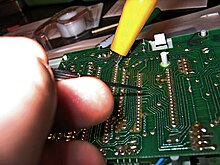Circuit bending: Difference between revisions
Phaedrus86 (talk | contribs) Revert to revision 112759989 dated 2007-03-05 07:13:45 by 76.170.95.100 using popups |
|||
| Line 45: | Line 45: | ||
* [http://www.oddmusic.com/illogic/index.html oddmusic.com's circuit bending section] - Gallery of some of Reed Ghazala's work, facts, history, tutorial, benders guide, tools of the trade and more |
* [http://www.oddmusic.com/illogic/index.html oddmusic.com's circuit bending section] - Gallery of some of Reed Ghazala's work, facts, history, tutorial, benders guide, tools of the trade and more |
||
* [http://www.getlofi.com GetLoFi] a circuit bending blog with a lot of circuit bending tips and resources |
* [http://www.getlofi.com GetLoFi] a circuit bending blog with a lot of circuit bending tips and resources |
||
* Cementimental - circuit-bending, experimental music, noise links |
|||
[http://www.cementimental.com/links.html Cementimental Linkpage] |
|||
[[Category:Electronics]] |
[[Category:Electronics]] |
||
Revision as of 08:09, 13 March 2007

Circuit bending is the creative short-circuiting of low voltage, battery-powered electronic audio devices such as guitar effects, children's toys and small synthesizers to create new musical instruments and sound generators. Emphasizing spontaneity and randomness, the techniques of circuit bending have been commonly associated with noise music, though many more conventional contemporary musicians and musical groups (such as Devo) have been known to experiment with "bent" instruments.
The experimental process
Circuit bending is a process that has been developed largely by individuals experimenting with second-hand electronics, often not associated with musical production. Aesthetic value, immediate usability and highly randomized results are often factors in the process of successfully bending electronics. Although the history of electronic music is often associated with unconventional sonic results, such innovators as Robert Moog, Lev Sergeivitch Theremin, etc. were electrical engineers and concerned with the consistency and sound design of their instruments. Circuit bending is typified by inconsistencies in the instruments built in an unscientific manner.
While many pre-fitted circuit bent machines are on offer for sale at auction sites such as eBay, this somewhat contravenes the intention of most practitioners. Machines bent to a repeated configuration are more analogous to the well known practice of mods, such as the Devilfish mod for the Roland TB-303, or various Analogman or [Pedaldoc] guitar pedal circuit modifications.
Typically, circuit bending is a matter of dismantling a piece of consumer electronics, connecting via wire or alligator clips any 2 circuit locations and sending current from one part of the circuit into another. Sonic results are monitored through the device's internal speaker or by connecting an amp to the speaker output. If an interesting effect is achieved, this connection would be marked for future reference or kept active, either with alligator clips, or a soldered connection, often routed through a switch. This is repeated in a trial and error basis. Overloading a component may produce undesirable effects, and thus the reliability of continued use or reproduction of effects in another scenario is unlikely. As a general rule, areas around the power supply or large capacitors are avoided to prevent damage to the electronic system.
Innovators in circuit bending
Although similar methods were previously used by other musicians and engineers, this method of music creation is believed to be pioneered by Reed Ghazala in the 1960s.
Ghazala's experience with circuit-bending began in 1966 when a toy transistor amplifier, by chance, shorted-out against a metal object in his desk drawer, resulting in a stream of unusual sounds. Ghazala has written of his discovery process in EMI magazine and recently for John Wiley & Sons, publishers of Ghazala's Extreme Tech project book Circuit-Bending, Build Your Own Alien Instruments
Mark Vail's book Vintage Synthesizers has a section in which Serge Tcherepnin, designer of the famous Serge modular synthesizers, discusses his early experiments in the 1950s with transistor radios, in which he found sensitive circuit points in those simple electronic devices and brought them out to "body contacts" on the plastic chassis. Prior to Mark's and Reed's experiments other pioneers also explored the body-contact idea, one of the earliest being Thaddeus Cahill (1897) whose Telharmonium, it is reported, was also touch-sensitive.
Significant instruments
A list of well known toys and instruments used in circuit bending usually because of their low price and 'bendability'
- Casio SK-1
- Speak & Spell
- Speak & Math
- Original Furby
Releases
Artists who create and use circuit bent instruments are featured on a compilation CD entitled "Noise and Toys Volume 1," which was officially released in 2006 on We Are... Records. Many varied musical intentions are apparent in this collection, but there is an almost physical tie binding these compositions.
Also in 2006 a Compilation was put out by TIGER CLAW RECORDS (Madison Wisconsin USA). It was titled "The Blown Circuit Comp- A Tribute to Circuit Bending" It features 12 bands from various locations around the globe. This was TIGER CLAWS first release.
See also
External links
- oddmusic.com's circuit bending section - Gallery of some of Reed Ghazala's work, facts, history, tutorial, benders guide, tools of the trade and more
- GetLoFi a circuit bending blog with a lot of circuit bending tips and resources
- Cementimental - circuit-bending, experimental music, noise links
